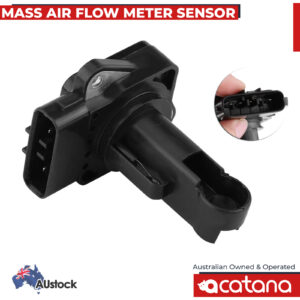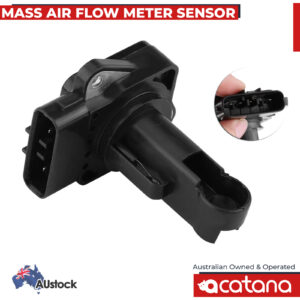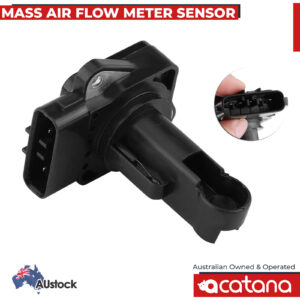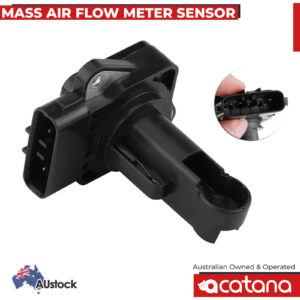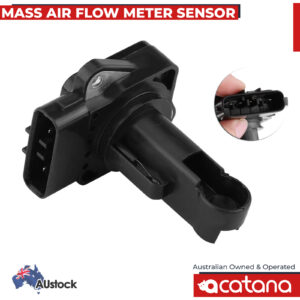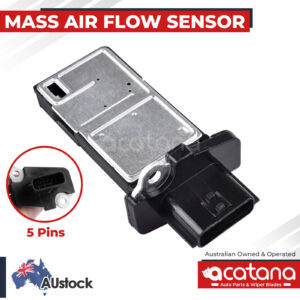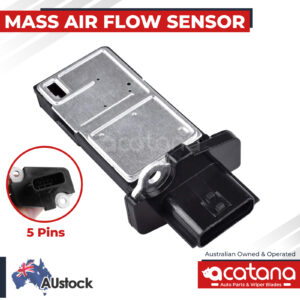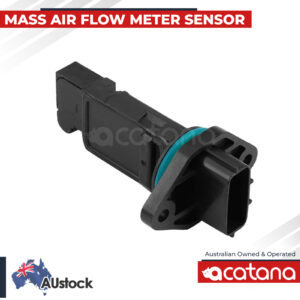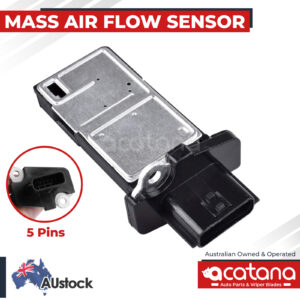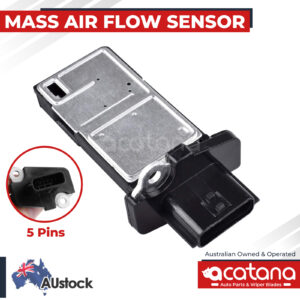MAF Mass Air Flow Meter Sensors
Shop by Filters
- Air Conditioning & Heating
- Car Care & Detailing
- Car Headlight Bulbs & Globes
- Car Keys & Remotes
- Drive Belt Parts
- Engine Cooling Components
- Find Car Parts by Make
- Fuel Delivery
- Fuel Pumps
- Ignition Systems & Components
- Interior & Body Parts
- New Arrivals Auto Parts
- Sensors
- ABS Wheel Speed Sensor
- Brake Light Switches
- Camshaft Position Sensors
- Crank Angle Position Sensors
- Diff Solenoid Valves
- Freewheel Actuators
- Idle Air Control Valves
- Knock Sensors
- MAF Mass Air Flow Meter Sensors
- MAP Manifold Absolute Pressure Sensors
- O2 Oxygen Sensors
- Oil Pressure Switches
- Sensors by Car Makes
- Suction Control Valve Sensors
- Timing Vacuum Sensors
- Vacuum Solenoid Valves
- Vanos Valvetronic Sensors
- Windscreen Washer Parts
-
4in1 Car Ceramic Armor Spray Coating - Shine Quick, Coat Wax Spray, Waterless, Polish $12.90
$29.00 -
OneLux Car Windscreen & Glass Oil Film Cleaner - Removal KIT, 30g $12.90
$29.00 -
PEGCIZ Car Interior Foam Cleaner Kit (100ml) $12.90
$29.00 -
Foaming Car Interior Cleaner Kit (110ml) $12.90
$29.00 -
Windscreen Washer Fluid Concentrate 30ml – Streak-Free Cleaner, Oil & Bug Remover, Eco-Friendly Solution $9.90
$29.00 -
Car Plastic Trim Restorer kit - Repair & Clean Nano Coating for Interior Parts, 50ml $15.90
$29.00 -
Windscreen Washer Fluid Tablets - Cleaner Concentrated, (Pack of 50pcs) $12.90
$29.00
- Brighter Lights – Bigger Savings! Get 20% OFF on car bulbs with promo code 28 February 2025
- 25% Off Wiper Blades – Limited Time Offer! 20 January 2025
- Is it difficult to buy the right auto part online? 21 November 2024
- How to Choose and Program a Car Key: Essential Tips and FAQs 8 August 2024
- Here’s What You Should Know About the Ignition Coils 29 March 2024
Welcome to AURUS Home MAF Mass Air Flow Meter Sensors category, where you’ll find a wide range of high-quality MAF sensors for your vehicle. Our MAF sensors are manufactured to meet or exceed OEM specifications, ensuring optimal performance and durability.
Showing 1–24 of 138 results
-
SKU: 1974002010-LRD4
Acatana MAF For Land Rover Discovery 4 Mass Air Flow Meter Sensor MR547077 ZLY113215
$35.90$99.00 -
SKU: 1974002010-LIS300
Acatana MAF For Lexus IS JCE10 Sedan 2001 – 2005 Mass Air Flow Meter Sensor MR547077
$35.90$99.00 -
SKU: 1974002010-LLS430
Acatana MAF For Lexus LS UCF30 Sedan 2000 – 2006 Mass Air Flow Meter Sensor MR547077
$35.90$99.00 -
SKU: 1974002010-MMPVLWS2
Acatana MAF For Mazda MPV LW Series 2 Mass Air Flow Meter Sensor MR547077 ZLY113215
$35.90$99.00 -
SKU: 1974002010-SIGDGDES
Acatana MAF For Subaru Impreza GD GDE 2002 – 2005 Mass Air Flow Meter Sensor MR547077
$35.90$99.00 -
SKU: 1974002010-SIGDAGGAW
Acatana MAF For Subaru Impreza GDA GGA 2002 – 2005 Mass Air Flow Meter Sensor MR547077
$35.90$99.00 -
SKU: 1974002010-SIGGGGAW
Acatana MAF For Subaru Impreza GG GGA 2000 – 2002 Mass Air Flow Meter Sensor MR547077
$35.90$99.00 -
SKU: 1974002010-TYNCP91H
Acatana MAF For Toyota Yaris NCP91 Hatch 2005 – 2011 Mass Air Flow Meter Sensor MR547077
$35.90$99.00 -
SKU: 1974002010-SIGDGDFS
Acatana MAF Mass Air Flow Meter Sensor for Subaru Impreza GD 2001 – 2006 2007 22680AA310, 22680-AA310
$35.90$99.00 -
SKU: 22680AD21A-OE
AFM Meter Sensor reliable replace to determine the Flow Mass rate of Air entering a fuel-injected internal combustion engine. Compatible with OEM 22794-AA010 C36-700K01 MF105B MF105HQ
$33.90$79.00 -
SKU: 8972534561-HRRA
AFM Meter Sensor For Holden Rodeo RA 1999 – 2006 reliable replace to determine the Flow Mass rate of Air entering a fuel-injected internal combustion engine. Compatible with OEM 8972534561
$41.90$79.00 -
SKU: 226807S000-OE
AFM Meter Sensor For Nissan reliable replace to determine the Flow Mass rate of Air entering a fuel-injected internal combustion engine. Compatible with OEM 22680-7S000 226807S000 MF21058N 336-60644
$32.90$79.00 -
SKU: 226807S000-NZ37
AFM Meter Sensor For Nissan 370 Z 2009 – 2018 Z34 reliable replace to determine the Flow Mass rate of Air entering a fuel-injected internal combustion engine. Compatible with OEM 22680-7S000 MF21058N 336-60644
$32.90$79.00 -
SKU: 226807S000-NC
AFM Meter Sensor For Nissan Cube 1998 – 2014 Z10 Z11 Z12 reliable replace to determine the Flow Mass rate of Air entering a fuel-injected internal combustion engine. Compatible with OEM 22680-7S000 MF21058N 336-60644
$32.90$79.00 -
SKU: 22680AD21A-NM
AFM Meter Sensor For Nissan Maxima A33 2001 – on reliable replace to determine the Flow Mass rate of Air entering a fuel-injected internal combustion engine. Compatible with OEM 22794-AA010 C36-700K01 MF105B MF105HQ
$33.90$79.00 -
SKU: 226807S000-NMU
AFM Meter Sensor For Nissan Murano 2005 – 2014 Z50 Z51 reliable replace to determine the Flow Mass rate of Air entering a fuel-injected internal combustion engine. Compatible with OEM 22680-7S000 MF21058N 336-60644
$32.90$79.00 -
SKU: 226807S000-NN
AFM Meter Sensor For Nissan Navara 1985 – 2018 D21 D22 D23 D40 reliable replace to determine the Flow Mass rate of Air entering a fuel-injected internal combustion engine. Compatible with OEM 22680-7S000 MF21058N 336-60644
$37.90$79.00 -
SKU: 226807S000-NPF
AFM Meter Sensor For Nissan Pathfinder 1986 – 2017 R50 R51 R52 reliable replace to determine the Flow Mass rate of Air entering a fuel-injected internal combustion engine. Compatible with OEM 22680-7S000 MF21058N 336-60644
$37.90$79.00 -
SKU: 226807S000-NP
AFM Meter Sensor For Nissan Patrol 1976 – 2018 reliable replace to determine the Flow Mass rate of Air entering a fuel-injected internal combustion engine. Compatible with OEM 22680-7S000 MF21058N 336-60644
$37.90$79.00 -
SKU: 22680AD21A-NPA
AFM Meter Sensor For Nissan Patrol 2000 – 2004 reliable replace to determine the Flow Mass rate of Air entering a fuel-injected internal combustion engine. Compatible with OEM 22794-AA010 C36-700K01 MF105B MF105HQ
$35.90$79.00 -
SKU: 22680AD21A-NPU
AFM Meter Sensor For Nissan Pulsar 1.6 1.8 2000 – 2004 reliable replace to determine the Flow Mass rate of Air entering a fuel-injected internal combustion engine. Compatible with OEM 22794-AA010 C36-700K01 MF105B MF105HQ
$35.90$79.00 -
SKU: 226807S000-NISPUL
AFM Meter Sensor For Nissan Pulsar 2003 – 2006 reliable replace to determine the Flow Mass rate of Air entering a fuel-injected internal combustion engine. Compatible with OEM 22680-7S000 MF21058N 336-60644
$32.90$79.00 -
SKU: 226807S000-NITIC11
AFM Meter Sensor For Nissan Tiida 2005 – 2013 C11 reliable replace to determine the Flow Mass rate of Air entering a fuel-injected internal combustion engine. Compatible with OEM 22680-7S000 MF21058N 336-60644
$37.90$79.00 -
SKU: 226807S000-NXT
AFM Meter Sensor For Nissan X-Trail 2003 – 2006 T30 reliable replace to determine the Flow Mass rate of Air entering a fuel-injected internal combustion engine. Compatible with OEM 22680-7S000 MF21058N 336-60644
$32.90$79.00
ABOUT Mass Air Flow Meter
What it is MAF Mass Air Flow Meter
A Mass Air Flow (MAF) sensor is an electronic device used in modern automotive engines to measure the amount of air entering the engine. It is an essential component of the engine management system, as the amount of air entering the engine determines the amount of fuel that needs to be injected to achieve the optimal air-fuel ratio for efficient combustion.
The MAF sensor works by measuring the amount of air flowing through the intake system using a heated wire or film. As air flows over the wire, it cools it down, and the MAF sensor detects this change in temperature to calculate the mass flow rate of air entering the engine.
The information from the MAF sensor is used by the engine control module (ECM) to adjust the fuel injection and ignition timing to maintain optimal engine performance and fuel efficiency. A faulty MAF sensor can cause a variety of issues, such as decreased engine performance, reduced fuel efficiency, and increased emissions.
Some common signs of a faulty MAF sensor include rough idle, stalling, hesitation or surging during acceleration, decreased power and acceleration, and increased fuel consumption. If you suspect that your MAF sensor is faulty, it is essential to have it diagnosed and replaced by a qualified technician to ensure the proper operation of your engine.”
Mass air flow sensor symptoms
The Mass Air Flow (MAF) sensor is an essential component of the engine management system, and when it malfunctions, it can cause a variety of problems. Here are some common symptoms of a faulty MAF sensor:
- Rough idle: A faulty MAF sensor can cause the engine to idle roughly or stall, making it challenging to keep the engine running at a constant speed.
- Reduced power and acceleration: If the MAF sensor is not providing accurate readings, the engine may not receive the correct amount of air, causing a loss of power and acceleration.
- Hesitation or surging during acceleration: A faulty MAF sensor can cause hesitation or surging during acceleration, making it feel as though the vehicle is lurching forward.
- Increased fuel consumption: If the MAF sensor is not working correctly, the engine may not receive the correct amount of air, leading to increased fuel consumption and reduced fuel efficiency.
- Check engine light: If the MAF sensor is malfunctioning, it can trigger the check engine light to turn on. This warning light may also indicate other problems, so it is essential to have the vehicle diagnosed by a qualified technician.
If you experience any of these symptoms, it is essential to have your vehicle inspected by a qualified technician. They can diagnose the issue and determine whether the MAF sensor needs to be replaced or repaired.”
Mass air flow sensor location
The location of the Mass Air Flow (MAF) sensor varies depending on the make and model of the vehicle. However, in most vehicles, the MAF sensor is located between the air filter box and the throttle body.
In modern vehicles, the MAF sensor is often located in the air intake tubing or housing, near the air filter box. It is typically a cylindrical or rectangular-shaped unit with a wiring harness connected to it.
To locate the MAF sensor in your vehicle, you can consult the owner’s manual or perform an online search for the specific make and model. Alternatively, you can visually inspect the air intake system to locate the MAF sensor.
It is essential to handle the MAF sensor with care, as it is a delicate electronic component that can be easily damaged. If you need to remove the MAF sensor for cleaning or replacement, be sure to follow the manufacturer’s instructions carefully and avoid touching the sensing element with your fingers or any other objects.”
Showing 1–24 of 138 results










